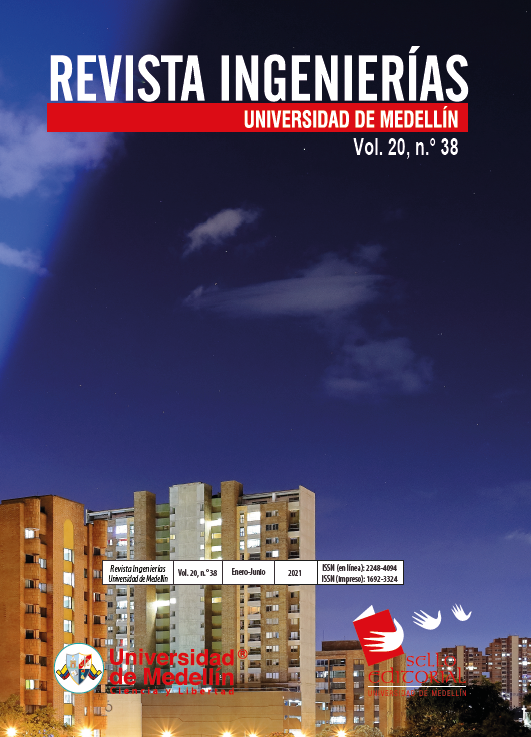Finite Element Analysis of An Evaporation System to Synthesize Kesterite thin Films
DOI:
https://doi.org/10.22395/rium.v20n38a3Keywords:
absorber-layer, Comsol, CZTS, evaporation, finite-elements, heat-distribution, kesterite, thin film solar cellsAbstract
Currently, there is an interest within the scientific community in thin-film solar cells with a Kesterite (Cu2ZnSnS4) type absorber layer, since they report a theoretical efficiency greater than 32 %. The synthesis of Kesterites by evaporation has allowed for efficiencies at the laboratory level of 11.6 %. Although these are good results, the design of the evaporation chamber and the distribution of the electrodes is essential to control synthesis parameters and evaporate each precursor in the corresponding stage. This project seeks to design an evaporation chamber that can achieve a vacuum of 10-5 mbar, increase the deposition surface and avoid each precursor evaporation in a non-corresponding stage. This last objective was studied using Comsol multiphysics R. (licensed product) software, with the adequate disposition of metallic precursors (zinc, copper, and tin) determined by analyzing heat distribution. It was concluded that the lower the evaporation temperature of the precursor, the smaller the height of the copper electrode in the system. This is because, with a lower height the concentration of heat in the container is lower.
Downloads
References
R. H. Bube, Photovoltaic materials: properties of semiconductor materials. Imperial Collage press, 1998.
J. C. Gonzáles, A. Abelenda, and M.Sanchez.Caracterización de capas delgadas de Cu2ZnSnS4 para aplicaciones fotovoltaicas. Habana: Universidad de la Habana, 2016.
S. Xiangbo, J. Xu, L. Ming, L. Weidong, L. Xi, and Z. Hua. “A review on development prospect of CZTS based thin film solar cellsâ€. HindawiLimited; International Journal of Photoenergy, vol 2014, p 1-11, 2014. http://dx.doi.org/10.1155/2014/613173
S. Thiruvenkadam, et al.,“Effect of Zn/Sn molar ratio on the microstructural and optical properties of Cu2Zn1-xSnxS4 thin films prepared by spray pyrolysis techniqueâ€. Physica B: Condensed Matter, vol 533, pp 22-27. https://doi.org/10.1016/j.physb.2017.12.065
J. B.Carda, T.Stoyanova, and R.MartÃ. “Obtención de estructuras calcopirita (CIGS) y kesterita (CZTS) como absorventes para dispositivos fotovoltaicos de capa fina mediante métodos de sÃntesis de bajo costeâ€. Ph. D. dissertation. Castellon de la Plana. Universitat Jaume I de Castellon, Castellon, 2016, p 228.
Y. P. Lin, Y. F. Chi, T. E. Hsieh, Y. C. Chen, and K.P. Huang. “Preparation of Cu2ZnSnS4(CZTS) sputtering target and its application to the fabrication of CZTS thin-film solar cells.†Journal of Alloys and Compounds, vol. 654, pp. 498-508. 2016. 10.1016/j.jallcom.2015.09.111
U. Chalapathi, S. Uthanna, and V. Sundara Raja.“Growth of Cu2ZnSnS4 thin films by co-evaporation-annealing route: effect of annealing temperature and durationâ€. Journal of Materials Science: Materials in Electronics, vol. 27, pp. 1048-1057, 2018. https://doi.org/10.1007/s10854-017-8005-0
T. Tunaka, et al. “Influence of composition ratio on properties of Cu2ZnSnS4 thin film fabricated by co-evaporationâ€. Thin Solid Films, vol. 518, pp. S29-S33, 2010. https://doi.org/10.1016/j.tsf.2010.03.026.
E. Garcia Llamas, et al. “Cu2ZnSnS4 thin film solar cells grown by fast thermal evaporation and thermal treatment.†Solar Energy, vol. 141, pp. 236-241. 2017. http://dx.doi.org/10.1016/j.solener.2016.11.035
M. Neuschitzer, E. Saucedo, and A. Pérez. Development of Cu2ZnSnS4 b ased t hin fi lm solar cells by PVD and chemical based processes. Ph. D. dissertation. España. Barcelona. Universidad de Barcelona, 2016, p 138.
S. Y. Lee, et al. .“Cu2ZnSnS4 thin-film solar cells by thermal co-evaporation with 11.6 % efficiency and improved minority carrier diffusion lengthâ€. Advance Energy Materials, vol. 5. 2015. https://doi.org/10.1002/aenm.201401372
X. Fontané Sanchez, A. Pérez Rodriguez, and V.Izquerdo Roca.Caracterización por espectroscopia Raman de semiconductores Cu2ZnSnS4 para nuevas tecnologÃas fotovoltaicas, Barcelona: Universidad de Barcelona, 2011, pp. 138.
Shiyou C. “Cu2ZnSnS4 Cu2Zn(SnSe)4, and related materials.†Semiconductor Materials for Solar Photovoltaic Cells, vol 218, pp. 75-103, 2016.
L. Escobar Alarcón, E. Rincón MejÃa and S. Chirino Ortega. Diseño de una cámara para el depósito de pelÃculas delgadas por ablación laser. Ph. D. dissertation. México, Universidad Autónoma del Estado de México, 2001, pp. 4.
C. Villamizar and J. Duarte. “Construcción de sistemas de presión en el intervalo de medio y alto vacÃo.†MET y FLU. pp. 35-47. 2019.
I. Gutiérrez Ortuño, Tratamiento y modificaciones de superficiales del acero. Provincia de Cádiz: Universidad de Cádiz, 2009, pp. 41.
M. Hurtado, G. Gordillo and E. Romero Malagón. SÃntesis y caracterización de pelÃculas delgada del semiconductor Cu2ZnSnS4 y su uso como capa absorbente en celdas solares. Bogotá D.C: Universidad Nacional de Colombia. 2014. pp. 42.
Downloads
Published
How to Cite
Issue
Section
License
The total or partial reproduction of the contents of the journal for educational, research, or academic purposes is authorized as long as the source is cited. For reproduction for other purposes, express authorization from the Sello Editorial Universidad de MedellÃn is required.

